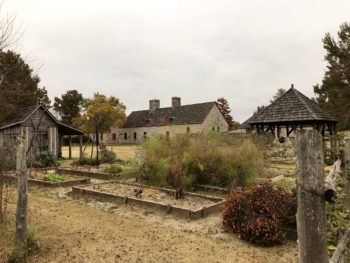
Autumn jardin potager
3 décembre 2018 lundi
38 degrees, Cloudy
10 mph, NW wind
“In the Canadian colonies, for both rich and poor, the concern and preference was for vegetables that could be preserved for eating out-of-season during the long winter months. Root vegetables such as potatoes, beets, carrots, and turnips were stored in root cellars for the winter. Squash and onions would last for a number of months before deteriorating. Cucumbers and cabbages were pickled. Beans, peas, and peppers were dried for use throughout the year in stews, soups, and baked dishes.”
Eileen Woodhead, Early Canadian Gardening and 1827 Nursery Catalog, 1998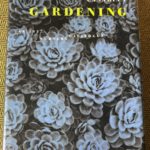
This opening quote was taken from a book I have been savoring this autumn concerning an early nineteenth-century garden catalog Ms. Woodhead discovered in the Toronto Library collection. Eileen is a material culture researcher and Qualified Plantsman, and she points out in her book exploring the historic horticultural significance of nursery catalogs, how often these catalogs are an overlooked source of period information. These types of sources have been a personal fount of useful information and direction for the habitant jardin potager at Fort de Chartres. The author notes that seventeenth-century immigrants to North America were encouraged to bring garden seeds on their journey from their homelands. As the colonist communities grew and became established, nursery catalogs began to appear late eighteenth-early nineteenth-century in North America. And it is interesting to note, and is often theorized, that after varieties of seeds became more widely used, they would appear in the nursery catalog listings generally 10 years after that particular seed variety’s first introduction to an area. It has been a lovely pastime at the close of this garden year to read and reflect upon her catalog narrative while admiring her plant illustrations of these centuries’ old heirlooms and their rightful place in this continent’s historic foodway journey.
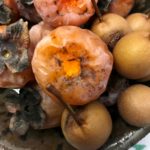
Native persimmons and wild pears
In the final days of this year’s challenging garden season, there is work still remaining, processing the last of nature’s and the jardin’s offerings. The garden’s progress during the year was often slow and halting due to early and late season cold and rain, accompanied by mid-season bursts of exuberant production fueled by the warm and dry weather of the summer months. Lately, time has been spent air drying the last of the peppers, carrots, and winter squashes, while the preserving of the gathered autumn fruits of apple, pear, and persimmon continues through the drying of fruit or the making of jams and fruit vinegars. And the processing of the fall’s harvests of native pecans, walnuts and hickory nuts takes center stage just in time for use in the upcoming holiday celebrations.
Harvesting seeds over the autumn months bring to a close this year’s garden’s journey, adding to the bounty of seed previously gathered throughout the year. This important garden task fulfills the last step in the garden cycle, saving the seed that brings the promise of life for our jardin in the new year. Over the winter, I will continue to create the jardin’s heirloom sample seed packets that are given away at events throughout the year as part of this garden’s mission, events like the annual Fort de Chartres Heirloom Seed Swap being planned for February 2nd in the Guard Room at Fort de Chartres. As in past years, we invite area gardeners at this event to share their own seeds and maybe experiment with new heirloom seed varieties from other gardeners in our community while sharing the jardin potager’s seeds and their long history, advocating for their inclusion in the modern garden.

New seed collections
A new endeavor begun last year has been the creation of French Colonial Jardin Potager heritage seed packet collections, such as Herb, Flower, and Early Spring Vegetables. This new project is a continuation of the garden’s mission of encouraging the direct sowing of seed to expand one’s plant choices in a time of rapidly decreasing plant options in modern stores and nurseries. There are now five varieties of heritage seed collections available online at the new Les Amis du Fort de Chartres online artisan shop, The Heart of the Illinois Country Heritage Shop. You are invited to review the selection and keep an eye to the new year for new seed collection varieties to be offered here at The Heart of Illinois Country/gardening. Any purchases at this online site support this jardienere’s efforts at the Fort’s Heritage Garden and also Les Amis’ efforts to promote area heritage artisans. The seed collections are packaged in an eighteenth century manor, which includes seed planting instructions and plant histories, with the packets sealed in red wax, with a nod to the era. It has been a very fitting way for this gardener to end the jardin season with scent of seeds and hot wax in the air, reminiscent of a time so very long ago.
In closing, in the spirit of the upcoming holidays, you are offered here a few heritage recettes (recipes), celebrating the last bounty of the season and the approaching joyful festivities. Joyeux Noël!
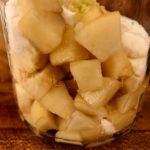
Fruit Vinegar Shrub
Colonial Apple Shrub Recipe
Makes about 1 1/2 cups
1 1/4 cups grated Honeycrisp apples (or your apple variety of choice)
3/4 cup organic cane sugar
1 stick of cinnamon (optional)
1 cup raw apple cider vinegar
Add apples, sugar, cinnamon ( if desired), and apple cider vinegar to a glass mason jar. Attach jar cover tightly and shake liberally. Refrigerate and let sit for 3-4 days.
Remove from refrigerator and strain juice into a large bowl. Squeeze remaining juice out of apples using a colander. Pour juice into a glass container and keep refrigerated. The refrigerated shrub will stay good for up to 6 months.
Adding a tablespoon of the shrub (or up to 1 oz according to taste) per cup or glass, the crisp flavor of the apples and tartness from the apple cider vinegar makes this shrub to be enjoyed with your choice of sparkling water, green or black tea, or if you prefer a shrub cocktail, with bourbon or whiskey, to be accompanied with ginger ale or club soda.
Illinois Country Spiced Nuts
1 ½ cups pecans or walnut halves
½ white or brown sugar
¼ cup water (can substitute a bit of juice of an orange in the water measure)
½ tablespoon grated orange rind
¼ teaspoon cinnamon
1/8 teaspoon ginger
1/8 tablespoon mace
Pinch of nutmeg
Combine all ingredients in a heavy skillet. Heat over medium temperature until the liquid boils. Stir constantly until all liquids have evaporated and nuts are coated with sugar and beginning to separate. Spread on platter, separating nuts and allowing them to cool.
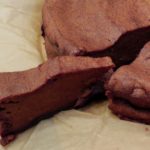
Persimmon pudding
Persimmon Pudding
Many similar variations of this recipe can be found throughout the Illinois country.
2½ cups flour
1½ cups sugar
2 teaspoons cinnamon
1 teaspoon cloves
1 teaspoon allspice
2 cups persimmon pulp
3 eggs
2 cups sweet milk
½ cup butter, melted
2 teaspoons vanilla (an 18th century substitute-brandy)
Mix together flour, sugar, and spices. Vary spice amounts according to personal taste. Stir in persimmon pulp, eggs, milk, melted butter, and vanilla. Bake in oven at 325° for about 1 hour.
Stafford Family Recipe, Stafford Historic Farm Persimmon Festival
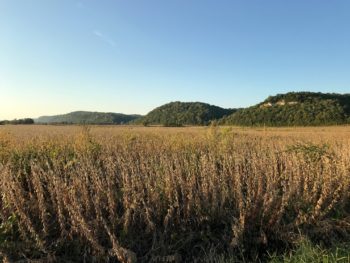 7 octobre 2018 dimanche
7 octobre 2018 dimanche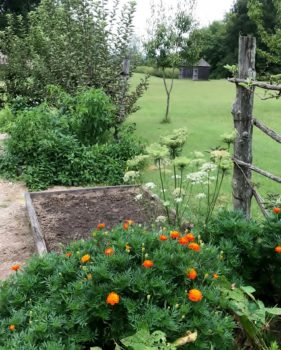
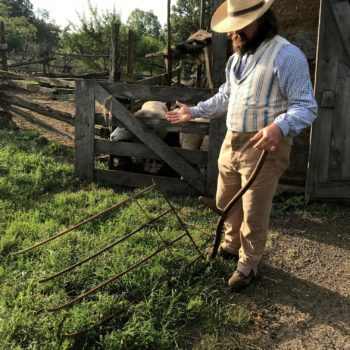
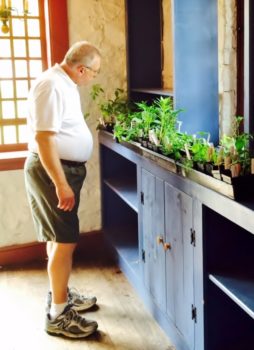
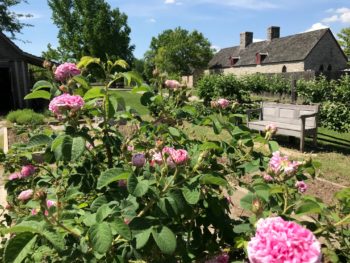 Reminder-this Sunday, June 10, is the 2nd Annual French Colonial Gardens Driving Tour. Enjoy a Sunday drive through the ‘French Colonial Corridor’ along the middle Mississippi River valley. Whether you begin your journey near Prairie du Rocher or Ste. Genevieve, these heritage gardens are sure to provide inspiration and enjoyment. Noon-5 PM.
Reminder-this Sunday, June 10, is the 2nd Annual French Colonial Gardens Driving Tour. Enjoy a Sunday drive through the ‘French Colonial Corridor’ along the middle Mississippi River valley. Whether you begin your journey near Prairie du Rocher or Ste. Genevieve, these heritage gardens are sure to provide inspiration and enjoyment. Noon-5 PM.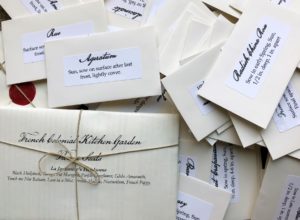
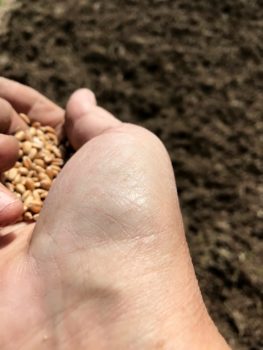


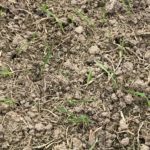
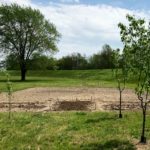
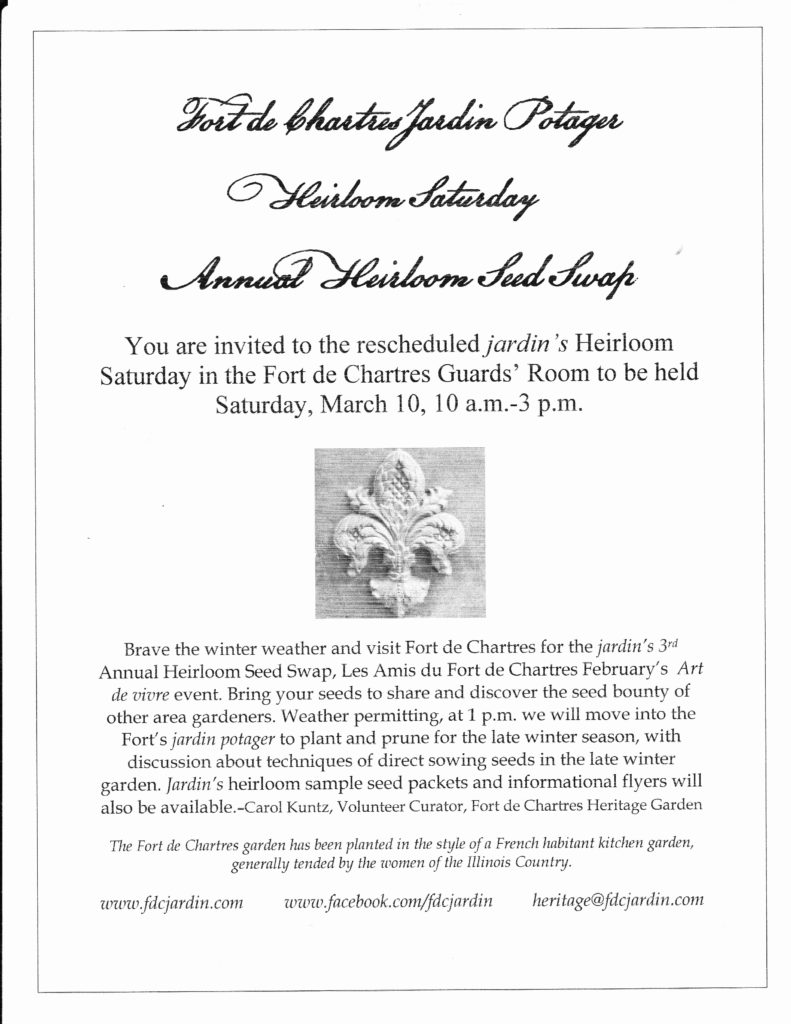
Recent Comments